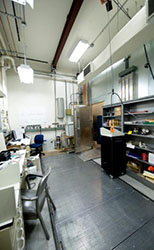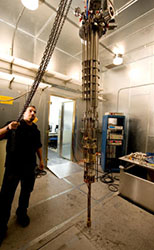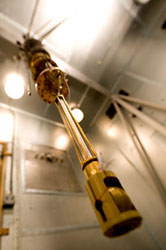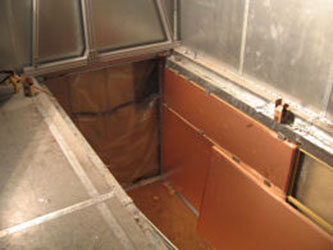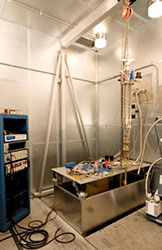|
| Low Temperature Lab These facilities serve to probe quantum materials at ultra-cold temperatures and high magnetic fields, utilizing magnetic field direction as a standard probe of anisotropy in strongly correlated electron systems. In conjunction with the use of CNAM central facilities, this equipment promises to provide unparalled insight into the details of one of the main experimental components is an Oxford 3He/4He dilution refrigeration system. This is equipped with a 17 T single-axis superconducting magnet and mechanical rotation stage. In addition, several insert adapters optimized for high-frequency experiments are included to allow versatility in the type and range of experiment performed at low temperatures. |
|
| Measurement Lab The main components of the lab include:
These are housed in an electrically sheilded metal room (described below) in order to eliminate noise and unwanted heating effects of RF radiation. |
|
| EMF Screened Room Ultra-low temperature experiments will be housed in a 12' x 17' EMF screened room equipped with a 6' cryostat pit. This "steel cage" is capable of 100 dB attenuation down to kHz frequencies, and is electrically isolated from surrounding building grounds. Two- and three-phase electrical power is supplied to the room through filters which prevent conducted signals from entering the enclosure, and a single-source true "earth" ground running from outside of the building provides electrical grounding of the cage and its internal power sources, eliminating noise and interference from ground loops.Custom vacuum lines have been built to connect cryostats to helium circulation pumps place in a remote location. |
|
| 17 T Single- Axis Magnet System The Oxford Instruments 15T/17T magnet is constructed from a Nb3Sn coil wound around a 2" experimental bore and is designed to operate in persistent or swept mode up to 15 T at 4.2 K and 17 T at 2.2 K. Euipped with a fully field-compensated zone to enable in-situ calibration of experimental thermometry regardless of field strength, this magnet is the "workhorse" for performing high-field thermodynamic and transport measurements in both fixed-angle and one-axis rotatable field-experiment angle configurations. |
|
| Dilution Fridge Mechanical Rotation System Our Oxford Instruments Dilution Refrigeration System is equipped with a one-axis mechanical rotator capable of rotating an experimental platform with respect to the vertical axis of the externally applied magnetic field. |
|
| Copper-Clad Screening Panels In order to accomodate the placement of the superconducting magnetics inside the screened room, it was necessary to install special non-magnetic copper-clad panels in the walls and floor of the pit area in order to maintain the EMF screening and prevent magnetic forces from disturbing magnet placement. |
|
| Vibration Isolation Methods The helium circulation system used for the dilution refrigeration cryostat is driven by rotary and booster pumps situated in a pit well removed from the experimental environment, ensuring isolation of mechanical and acoustic vibration problems. To further decouple the experimental platform from external vibrations, the cryostat/magnet dewar assembly is supported by a table platform that rests on pressurized air cushions supported above the dewar pit. |



